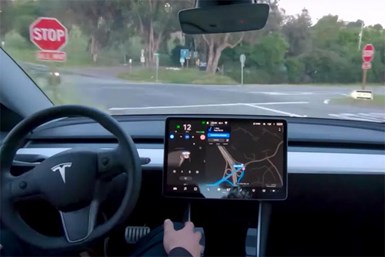Tesla Hikes Price of “Full Self-Driving” Tech as Beta Testing Begins
NHTSA to keep close tabs on safety
Want to save $2,000 on Tesla’s upcoming “Full Self-Driving” (FSD) software package? You’d better act fast.
In a tweet this morning, CEO Elon Musk said the carmaker is hiking the “pre-sale” price of the system from $8,000 to $10,000. Effective Monday.
This follows a $1,000 jump in July. And the price is likely to increase a lot more…for a feature that has just begun beta testing.
“The FSD price will continue to rise as the software gets closer to full self-driving capability with regulatory approval,” Musk says. As a result, he reasons, “the value of FSD is probably somewhere in excess of $100,000.”
Fully What?
As a reminder, the FSD system Tesla began allowing select customers to “cautiously” test earlier this week isn’t fully autonomous. At least not by SAE’s Level 5 definition, which takes drivers completely out of the equation (i.e., hands-free, eyes-off-the-road operation with no intervention).

The latest version of Tesla’s Autopilot technology—one of the most advanced systems available—typically is characterized as Level 2 or 2+ on the SAE spectrum. This means a car can operate itself under certain situations, but drivers must keep their attention on the road at all times and be prepared to quickly take control if needed.
The beta version of FSD includes several upgrades over the standard Autopilot, which Tesla has regularly updated since introducing the technology in 2015. FSD capabilities include:
- Expanding use beyond highways, including automated lane-changing on other multi-lane roads
- Completing left and right turns at intersections
- Navigating around other vehicles and objects
As with previous enhancements, the new FSD software is installed via over-the-air updates. Tesla claims the base Autopilot hardware has been primed for full autonomy for about four years.
“Cautious” Rollout
In a disclaimer issued to owners testing FSD, Tesla stresses the need for users to be ready to quickly retake control of the vehicle if needed.

“Full self-driving is in early limited access beta and must be used with additional caution,” the carmaker warns, adding that drivers should be especially vigilant around blind corners, crossings, intersections and through narrow passageways.
“It may do the wrong thing at the worst time,” Tesla adds, “so you must always keep your hands on the wheel and pay extra attention to the road. Do not become complacent.”
The initial rollout is limited to an undisclosed number of "expert, careful" drivers, several of whom have posted videos of FSD in action. But the carmaker plans to quickly expand beta testing and expects wide availability by year-end.
This will allow the system’s neural network to learn from the real-world testing and tweak algorithms on the fly for a more robust performance, according to Tesla.
Differing Opinions
Not everyone agrees with the approach. In fact, most competitors have been critical.
The Partners for Automated Vehicle Education (PAVE)—a 60-member consortium that includes Audi, Daimler, Ford, General Motors, Toyota, Waymo and Volkswagen—summed up its opposition this way:
"Public road testing is a serious responsibility, and using untrained consumers to validate beta-level software on public roads is dangerous and inconsistent with existing guidance and industry norms.”
The National Highway Traffic Safety Administration also weighed in, albeit in a slightly more diplomatic way. The regulatory agency says it has been briefed on FSD, which it refers to as an expansion of Tesla’s current driver-assist system.
Vowing to closely monitor the technology, NHTSA says it “will not hesitate to take action to protect the public against unreasonable risks to safety."
NHTSA and other regulators have investigated several accidents involving Tesla vehicles operating in Autopilot mode. In at least one case, the system has been faulted for being partly to blame for a crash.
Bottom Line
Fully automated vehicles are still several years away.
But Tesla continues to push the technology forward, even if it isn’t as fast as Musk previous as targeted. And it’s clear that prices will escalate as new features are added.
RELATED CONTENT
-
On Automotive: An All Electric Edition
A look at electric vehicle-related developments, from new products to recycling old batteries.
-
Cobots: 14 Things You Need to Know
What jobs do cobots do well? How is a cobot programmed? What’s the ROI? We asked these questions and more to four of the leading suppliers of cobots.
-
on lots of electric trucks. . .Grand Highlander. . .atomically analyzing additive. . .geometric designs. . .Dodge Hornet. . .
EVs slowdown. . .Ram’s latest in electricity. . .the Grand Highlander is. . .additive at the atomic level. . .advanced—and retro—designs. . .the Dodge Hornet. . .Rimac in reverse. . .








